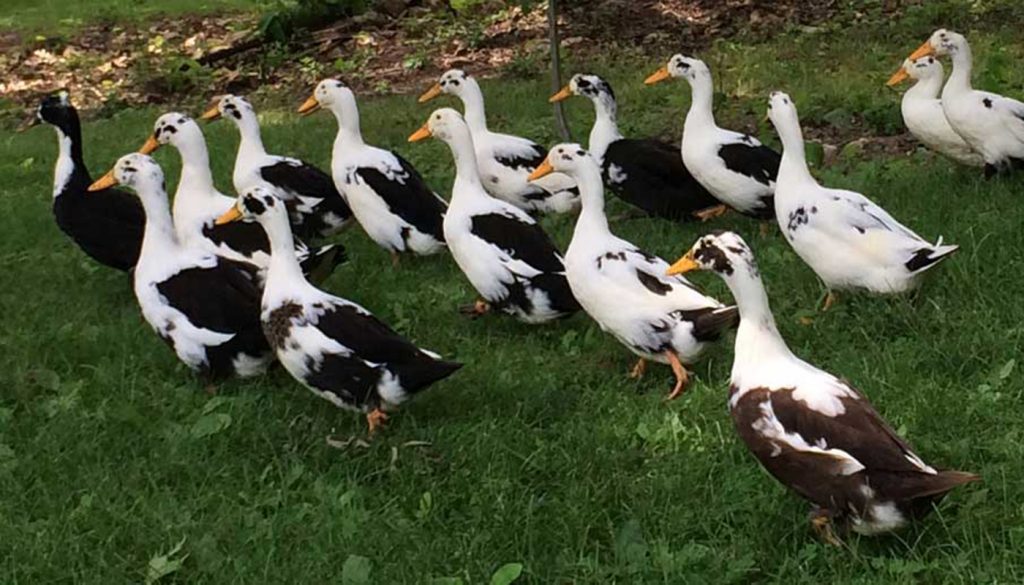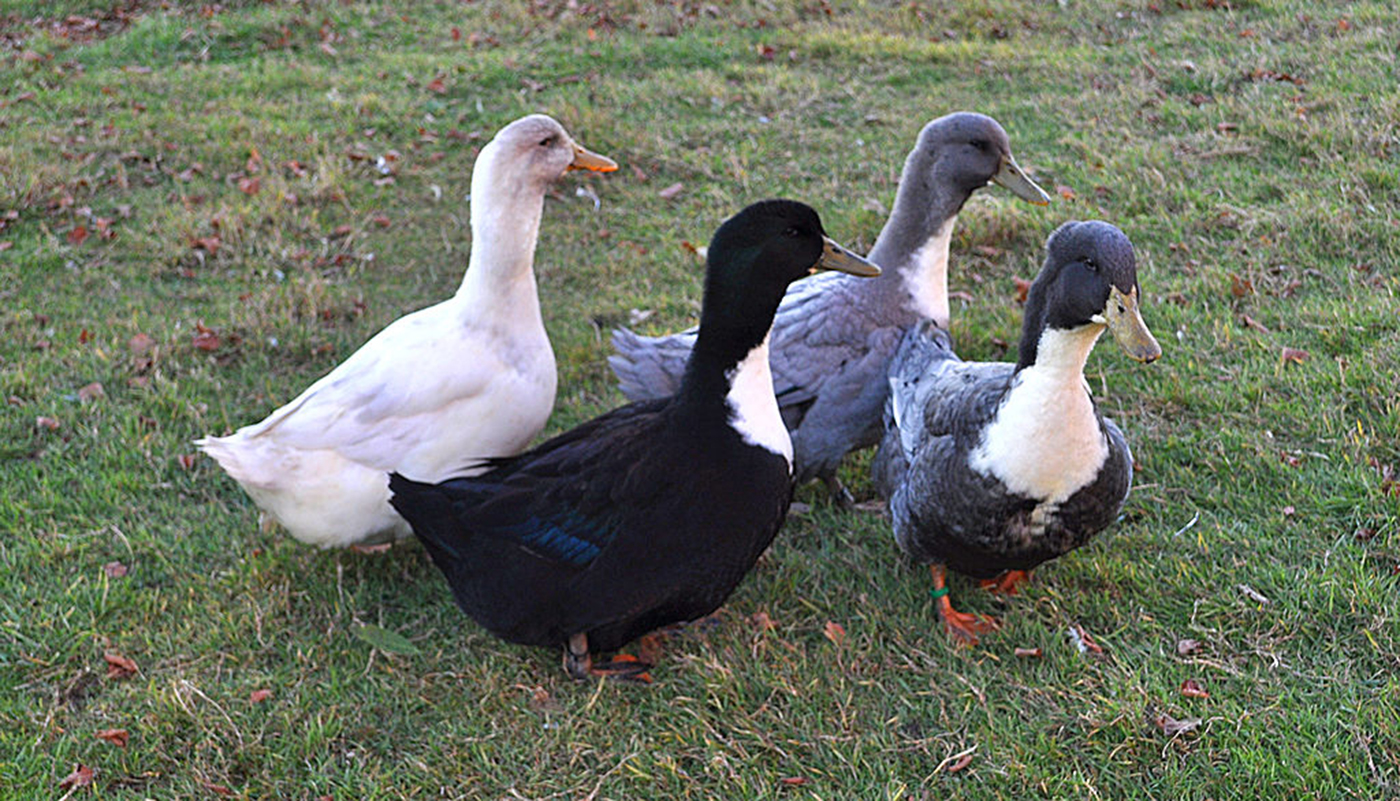
The Ancona is one of my favorite breeds of duck. They have beautiful white feathers splashed with various black patterns on them. There are no two ducks that have the exact same markings. Their coloring has been likened to that of the Holstein cattle as there are no set patterns or design to their markings.
They are a great dual-purpose breed that lay a large number of largely white, cream or blue eggs. They also have a very good quality of delicious lean meat. They have a very calm and friendly temperament are great foragers and make excellent pets. They are great for first-time duck owners.
GENERAL INFORMATION |
|
|---|---|
| Country of Origin: | England/America – the origins are unclear |
| American Poultry Association: | Not Recognized by the American Poultry Association |
| Duck Category: | Medium |
| Duck Class: | Unclassified |
| Colors: | White with black spots/splotches |
| Good starter duck? | Yes |
| You may Also Like: | TOP 10 GOOD STARTER DUCK BREEDS |
| Bantam Variety Available? | No |
| You may Also Like: | 10 BEST BANTAM DUCK BREEDS |
APPEARANCE / IDENTIFICATION
| DUCK BITS | DESCRIPTION | COLOR | |||||||
|---|---|---|---|---|---|---|---|---|---|
| EYES⇒ | Black | ||||||||
| BILL⇒ | Medium | Mottled Yellow | |||||||
| *Black bean tipped | |||||||||
| CRESTED? | No | ||||||||
| LEGS⇒ | Medium Same for M & f | Yellow/Mottled Yellow | |||||||
| Positioned proportionally apart to the width of their body | |||||||||
| FEET⇒ | Same for M & F | Yellow/Mottled Yellow | |||||||
| The spots on the feet increase with the duck’s age | |||||||||
| WINGS⇒ | Same for M & F | May have black markings | |||||||
| White with mottled black markings that can sometimes cover the entire wing | |||||||||
| FEATHERS⇒ | Same for M & F | White with Black Markings | |||||||
| Both M & F have white feathers with black spots/splotches or mottled marking | |||||||||
| SKIN COLOR⇒ | White/Yellowish | ||||||||
| Depends on what they are fed | |||||||||
| AVERAGE WEIGHT⇒ |
|
||||||||
| *Bean: This is also called the nail. It is a small round bump found at the end of the duck’s bill. It is used for defence and to catch insects. It is almost like a fingernail and is damaged can grow back. It can also get overgrown much like fingernails if they do not have something to grind it down on. | |||||||||
| ** Note: This is an average weight for the male duck and not a guaranteed weight | |||||||||
USE/PURPOSE |
||||||||||||||||||||||||||||||||||||
|---|---|---|---|---|---|---|---|---|---|---|---|---|---|---|---|---|---|---|---|---|---|---|---|---|---|---|---|---|---|---|---|---|---|---|---|---|
Females/Hens⇒ |
Dual purpose bird even though it is not a heavy breed it can still be used for its meat. Ancona ducks tend to have a tasty high quality of meat.
|
|||||||||||||||||||||||||||||||||||
Males/Drakes⇒ |
They are good breeders, pets and have a good quality lean meat
|
TEMPERAMENT |
|
|---|---|
| “These are really smart ducks that are also very sociable ducks. They tend to create a special bond with both their flock and humans.” | |
| Good with Kids? | They are good to have for teaching supervised kids how to tend to and care for ducks |
| You may Also Like: | 10 BEST DUCK BREEDS TO KEEP AS FAMILY PET |
| Flyers? | They are poor flyers and usually do not even attempt to |
| Noisy Birds? | They are not as noisy as chickens, but they do like to have a chat |
| Interact with other ducks? | They are a very sociable breed that likes to mingle |
| Best duck breeds to mix them with: | Any domesticated variety of duck |
| Other animals? | They are not too fussed around other domestic animals. They tend not to get into scraps with them as they are quite animal savvy and know how to avoid predators and bad situations. |
IDEAL ENVIRONMENT |
|
|---|---|
| “This breed is a really good forager and the love to nose about looking for grubs, slugs and snails” | |
| Ideal Garden Size? | Medium to large |
| Can be Confined? | Yes but they really do not like it as they like to be out and about |
| Free-Range | They will not wander too far from their home |
| Penned Free-Ranging? | As long as there are fresh grass and patches for them to get their grubs |
| Foragers | Excellent foragers |
| Endures heat well | As long as there is fresh cool water for them to drink and dip into |
| Endures cold well | Make sure they have a nice cozy place for them the huddle in outside and inside their duck house |
| Special Requirements? | Other than the normal pool or pond |
| Ideal Duck House: | A nice duck house that is adequately sized to house all the ducks |
| Ideal Duck Pond: | A kiddie’s plastic paddling will do. But if you can manage a nice shallow small pond that would be a lot better |
| Flock/Paddling Size: | 2 or more ducks in the flock |
| You may Also Like: | 22 Best DOMESTIC DUCK BREEDS |
GOOD TO KNOW |
|
|---|---|
| “The Ancona duck does not have any special requirements as they are quite a low maintenance self-sufficient breed. But they are listed as rare and critical at the American Livestock Conservancy” | |
| Special Care/Attention Requirements? | Check with the American Livestock Conservancy |
| Known Predators: | Check with animal control in your area for known predators |
| Conservations Status: | Critical/Watch For more information on poultry, conservation status, check the American Livestock Conservancy Website |
| Breeders Clubs: | It is best to check with the American Poultry Association for various clubs and or organizations. |
| Where to buy them: | Purely Poultry, Cackle Hatchery or check with the American Livestock Conservancy |
| Other: | If you do not want to risk having your ducks shipped check with your local poultry farms for advice on your nearest supplier. |
HISTORY
There was a lot of controversy over the origins of the Ancona duck. It was at first believe to have originated in Britain. But extensive research both in America and Britain now points to the origins of the Ancona being from the United States.
There is a piece of text that was written in the 1913 Water Fowl Club of America’s Yearbook. In this text, W.J. Wirt in Knowlesville, New York writes about developing a new breed of duck that he has called the Ancona. W.J. Wirt lived on Ridge View Farms and it was here that he allegedly developed this delightful breed.
W. J. Wirt claimed to have developed the breed by breeding a combination of several standard breeds of duck. It was not long after this publication the that Ancona Duck was listed in the American Poultry Yearbook of receiving two first place wins in the Boston Show in 1915.
Health
They do not have any major known health issues. But all domestic animals should have regular health and pest checks. Ensure they are vaccinated if required.
- Ducks need water to ensure they do not get “wet feather” disease. This is where the preening gland dries out. Water also stops them from getting pests such as mites, fleas, ticks, lice, etc.
- Well, fed ducks should hardly have any health issues.
- Any birds kept in a flock need to be dewormed. Although ducks are not as prone as other poultry they should still have a de-worming regime. Speak to a local vet or poultry experts for advice. Our article on Healthy Ducks has some great tips and advice on de-worming ducks.
 Crested Duck Breed – Everything You Need to Know
Crested Duck Breed – Everything You Need to Know The Types and Breeds of Ducks – Getting your Ducks in a Row – Part 1
The Types and Breeds of Ducks – Getting your Ducks in a Row – Part 1 Duclair Duck Breed – Everything You Need to Know
Duclair Duck Breed – Everything You Need to Know Orpington Duck Breed – Everything You Need to Know
Orpington Duck Breed – Everything You Need to Know Keeping Backyard Ducks – Pros and Cons
Keeping Backyard Ducks – Pros and Cons Gadwall – Wild Dabbling Duck Breed
Gadwall – Wild Dabbling Duck Breed Swedish Blue Duck Breed – Everything You Need to Know
Swedish Blue Duck Breed – Everything You Need to Know Welsh Harlequin Duck Breed – Everything You Need to Know
Welsh Harlequin Duck Breed – Everything You Need to Know Wood Duck – Wild Dabbling Duck Breed
Wood Duck – Wild Dabbling Duck Breed Cayuga Duck Breed – Everything You Need to Know
Cayuga Duck Breed – Everything You Need to Know